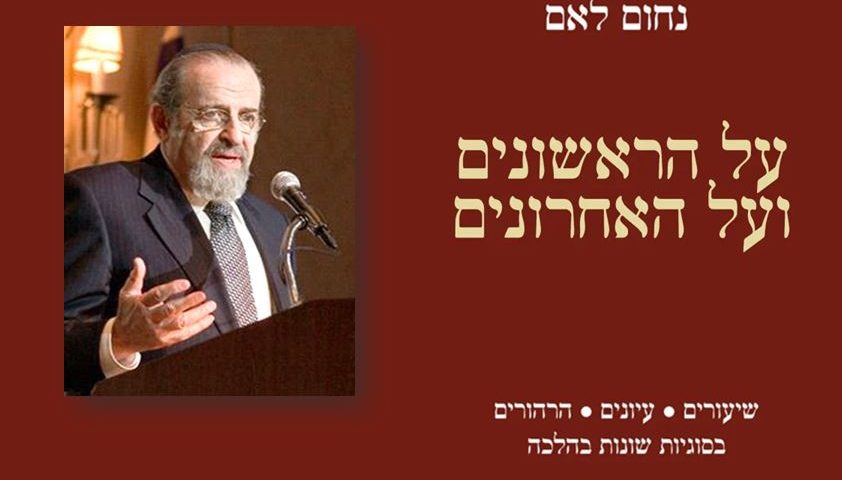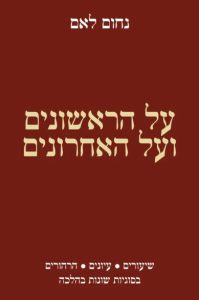Darshanut Meets Lomdus

Nahum Lamm, Al Ha-Rishonim ve-al Ha-Aharonim: Shiurim, Iyyunim, Hirhurim be-Sugyot Shonot ba-Halakha (Kodesh Press), 173 pp.
 Upon reading the newly published Hebrew language volume of Rabbi Dr. Norman Lamm’s essays on Talmudic sugyot and halakhic questions, I could not help but once again marvel at his unique ability to blend homiletics with classical yeshiva lomdus.
Upon reading the newly published Hebrew language volume of Rabbi Dr. Norman Lamm’s essays on Talmudic sugyot and halakhic questions, I could not help but once again marvel at his unique ability to blend homiletics with classical yeshiva lomdus.
As a self-proclaimed “unrepentant darshan,” R. Lamm z”l was renowned for his ability to expound upon midrashim and Torah commentaries in ways that illuminate our understanding of philosophy, human psychology, and religious experience in memorable and masterful prose.
But R. Lamm was also an accomplished lamdan. His youthful insights as a budding scholar were cited by his distinguished grandfather, Rabbi Yehoshua Baumol z”l, in the latter’s classical work, Emek Halakha. After he became President of Yeshiva University, R. Lamm regaled Yeshiva faculty and students by delivering a high-level Talmudic shiur each year for the annual yahrtzeit lecture in memory of R. Yitzchak Elchanan Spektor z”l and R. Samuel Belkin z”l. The present volume, a companion piece to his previous book Halakhot ve-Halikhot (Mossad HaRav Kook, 1989), is a collection of those shiurim, together with other essays in lomdus penned over the years.
[Read TRADITION’s Rabbi Norman Lamm Memorial Volume (Summer 2021) dedicated to our journal’s founder.]
I had the privilege, together with many others, to attend many of these shiurim, and I vividly recall R. Lamm’s spellbinding oratory as well as his colorful presentations of much of the subject matter that is captured in this volume. However, my most enduring memory is of the humanity of his shiurim, how he wondrously translated the esoteric disputes between Abaye and Rava, Rambam and Ra’avad, the Taz and Shakh, into homiletical insights regarding the human condition, and a greater understanding of our spiritual purpose and mission in this world. R. Lamm the darshan navigated the Sea of Halakha hand in hand with R. Lamm the lamdan.
Thus, for example, in an essay regarding the principle of osek ba-mitzva patur min ha-mitzva (a person involved in one mitzva is exempted from other commandments), R. Lamm utilizes a technical dispute between classical Talmud commentaries as a springboard for an evaluation of the two classical Jewish philosophical approaches as to whether the purpose of performing the commandments is to form a bond with Hashem or whether it is for the purpose of perfecting oneself and the surrounding universe. He argues that according to the opinion of Rashi, who holds the exemption in such a case applies even when it would be possible to perform both mitzvot, the purpose of mitzva observance is to connect with Hashem. Therefore, there is no need to fulfill the competing command if one is already connected to Hashem through the first mitzva. However, according to the contrary opinion of Tosafot, who hold that if possible both mitzvoth need be performed, the purpose of mitzvot is to perfect oneself and the world in different ways through each individual mitzva. Therefore, the more mitzvot that one can perform, the better.
Another essay finds profundity in the parameters of the principle of hoda’at ba’al din ke-meah edim dami, a person is believed to make a self-incriminating monetary admission but is not believed to make a criminal admission that would subject him to bodily punishment. R. Lamm utilizes this distinction to engage in a general philosophical inquiry regarding human autonomy. He quotes the Radvaz who cites the verse that “all souls are Mine” (Ezekiel 18:4) as explaining that a person has no right to inflict harm upon his body since he does not own his body (rather, God does), while he may relinquish his finances since he does in fact own his money. Building upon this idea, R. Lamm posits that the relationship between Hashem and mankind is akin to that of a bailor and bailee, or that of a lender and borrower. As borrowers, we have full autonomy to do with our lives in accordance with our will, but we also incur full responsibility for harming ourselves physically or spiritually, just as a borrower is responsible for theft, loss, and even accidental damage to the borrowed item. In addition, we are also bailees with respect to our lives, and at a certain time the bailor, who is Hashem, can be expected to claim His bailment. With respect to our money, however, our relationship to Hashem is solely that of a borrower, since money that is loaned is meant to be spent (milve le-hotza’a nitna). However, despite our rights over our own money, we need to return its value to our Divine lender through charity, good deeds, and scrupulous compliance with Jewish monetary law.
In a separate essay regarding the nature of the acquisition of objects through “arba amot shel adam” (a person’s four cubits), R. Lamm seizes upon a comment of the Ba’al ha-Maor who writes that a person’s four cubits constitute his private domain for purposes of the laws of carrying on Shabbat (so that one who throws an object further than that distance while standing in a public domain is considered to be throwing from his private domain into a public domain and is in violation), to develop the concept that a person’s four cubits constitutes his “natural domain.” However, R. Lamm adds that the Ba’al ha-Maor would acknowledge that there is an additional quality to a person’s four cubits– namely that a person is able to effectuate a a kinyan (a formal acquisition) of any object situated within his space of four cubits (arba amot shel adam konot lo).
R. Lamm then relates this dichotomy to two statements of Rambam, who writes that a person can come to fulfill the mitzva of loving and fearing Hashem through an appreciation of nature (Hilkhot Yesodei HaTorah). However, elsewhere, Rambam teaches that the way to fulfill the mitzva of loving Hashem is through an understanding of mitzvot and Torah study (Sefer HaMitzvot). R. Lamm creatively utilizes these sources to expound upon his understanding of Torah u-Madda, the long-time educational vision of Yeshiva University. Madda, avers R. Lamm, constitutes one’s natural relationship with Hashem in this world, much like a person’s “four cubits” for purposes of the laws of Shabbat as delineated by the Ba’al ha-Maor. However, a kinyan requires a stronger connection between the parties effectuating the transaction, and a true understanding of Hashem similarly only arises through the kinyan of the “four cubits of halakha,” of comprehending Torah through the mitzvot He gave to us.
Along these lines, one can find a healthy dose of Madda in the volume, from R. Lamm’s analysis of cardinal numbers vs. ordinal numbers in his discussion of sefirat ha-Omer at the beginning of the volume (he explains that saying ba-Omer is more consonant with viewing the days of the Omer as cardinal numbers which stand as independent entities, in which case no single day of counting is dependent on the counting of the previous day), to his citation from Elie Wiesel’s book Night regarding concentration camp victims who said Kaddish for themselves on the train to Auschwitz (to buttress his novel argument that mourning actually precedes death). But the unmistakable focus of this volume is upon classical Torah sources, al ha-Rishonim ve-al ha-Aharonim.
Towards the end of the collection, R. Lamm shares some of his psychological and ethical insights. He notes that Rambam in the laws of Shabbat seems to indicate that any anger which is for the sake of appeasing one’s temper –is constructive in nature, and thus, in the context of destroying objects to mitigate that anger, would incur liability on Shabbat. However, in the laws of De’ot (proper character traits), Rambam indicates that constructive anger must have a mitzva component (such as feigning anger to educate one’s children where appropriate) and only consist of an outward exhibition of anger. R. Lamm uses this distinction as a springboard to explain that Rambam has different categories for halakha and musar. From a halakhic perspective, what counts is that which one does to appease his inclination psychologically(le-yitzro), while from the lens of musar, it is only acceptable to demonstrate anger for the sake of Hashem (le-yotzro) and in a manner that emulates His ways.

Rabbi Norman Lamm z”l
Both in this instance and throughout the volume, R. Lamm demonstrates his love for language, and he can’t resist suggesting novel insights based on linguistic observations. For example, he notes in the context of lighting Hannuka candles that when the Talmud speaks about fulfilling the mitzva in a fashion of mehadrin, the word can be understood as referring to “returning” (as in the Aramaic usage), or “beautifying” (according to the word’s Hebrew origin). He argues that if the emphasis on Hannuka is on the miracle of the oil, then all the candles are the same, and one is merely “returning,” which helps to explain the opinion of the Shulhan Aruckh that one can light from one candle to another candle. However, if the emphasis is on the military victory, then only one candle is necessary, and the others are only for “beautifying,” in which case one can better understand the opinion of the Rema that one may not light from one candle to another, because they are not all “equal.” While this may seem to be a whimsical explanation, it is an intriguing display of both R. Lamm’s creativity and affection for wordplay.
Also noteworthy in terms of his linguistic acuity is an interpretation of Rabba bar Rav Huna’s statement that the head of a household should recite “be-nihuta” the three statements that the Mishna requires a husband to say in his home on erev Shabbat: “Have you tithed? Made an Eruv? Light the candles” (Shabbat 34a). The simple understanding is that be-nihuta means that the statements should be expressed gently. However, Rambam only records that the head of the household should tell his family to light the candles, ignoring the first two questions. R. Lamm explains, based on various comments of Rashi and with prooftexts to buttress his argument, that the word be-nihuta in this context means that the head of the household should indicate that it is “obvious” that the tithing and the eruv took place, so all that is left is to say, “light the candles.”
I was particularly intrigued by R. Lamm’s essay regarding the nature of repentance motived by love, when according to the Talmud one’s “intentional sins are converted into merits” (Yoma 86b). He argues from a rationalistic perspective that one cannot retroactively change the realities of the past, despite the notion of the time continuum made famous by R. Soloveitchik. Rather, the point of transforming one’s past sins into merits is that a person who reaches the level of repentance out of love is someone who has repented in deed, and not merely in thought, to the degree that he has become a different person (as Rambam writes regarding the ideal level of teshuva) so that he has effectively wiped the effects of the past sin away from his essence.
The volume also includes R. Lamm’s riveting exposition regarding the semikha controversy of the sixteenth century, centered upon the different understandings of Rambam’s opinion that ordination could be reinstituted upon the agreement of all the sages of the Land of Israel, which Rambam qualifies in Hilkhot Sanhedrin with the words “the matter requires final resolution.” In a footnote, R. Lamm quotes the first President of Yeshiva University, Dr. Bernard Revel, who understood that these words were a later textual emendation not penned by Rambam. R. Lamm notes his disagreement before proceeding to interpret Rambam’s words in his own original fashion (see the essay for further elaboration). This terse sidebar illuminates another key feature of his shiurim, namely that of serving as a continuing chain in the proud learning tradition of the Yeshiva that he so faithfully embodied.
There is much in this volume for any seasoned talmid hakham to appreciate. Although one can quibble with some of his explanations and conclusions, R. Lamm presents a stimulating review of many classical Talmudic discussions, and in the process challenges the reader to ponder the homiletical lessons and insights that he creatively culls in the process.
Rabbi Yona Reiss, a member of the TRADITION editorial board, serves as the Av Beth Din of the Chicago Rabbinical Council.
